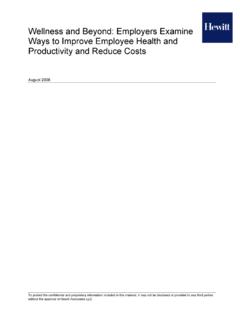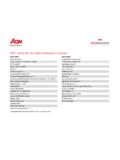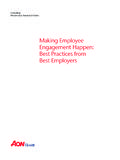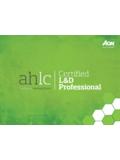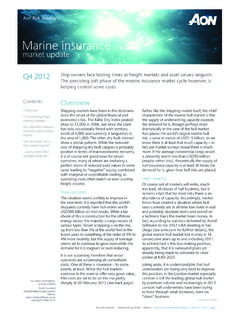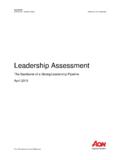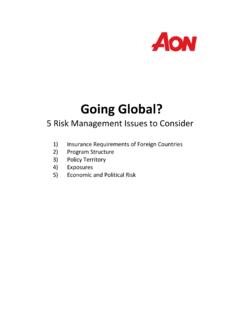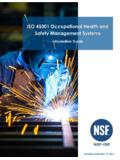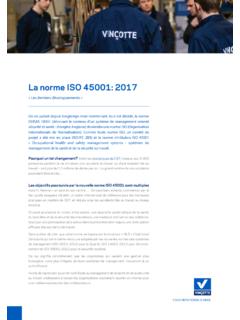Transcription of ISO 45001- Safety Management System Discussion …
1 Aon Risk Solutions Aon Global Risk Consulting ISO 45001 - Safety Management System Discussion Abstract May 2016. Risk. Reinsurance. Human Resources. Aon Risk Solutions Aon Global Risk Consulting Summary of Safety Management Standards Safety Management is a topic of significant concern for many organizations. When you consider how many activities must be undertaken and overseen to execute and implement a successful organization- wide Safety process, results demonstrate the investment provides clear and measurable value. Although different organizations and industries face unique risks and have distinct Safety requirements, there remains a commonality in Safety practices that can be managed within certain tolerances.
2 Additionally, fundamental practices, such as risk identification and assessment, incident investigation, employee engagement, and auditing, have universal application among organizations worldwide. To this end, a number of consensus standards have been established that provide guidance to help organizations establish internal Safety Management protocols. These standards provide the foundation and framework that enable organizations to model Safety practices and activities. These standards provide guidance for the development, implementation, execution, and sustainment of Safety Management practices.
3 These standards are often specific to the country or environment where the organization conducts its operations and in turn allows firms to address region- or country-specific regulatory expectations enabling them to tailor the standard's expectations to meet those regulations. However, this has also resulted in a plethora of standards which vary in some notable ways. In an attempt to expand the degree of standardization of Safety practices, the International Standards Organization (ISO) began working on unifying Safety standards. This effort traces its roots back to the mid-2000's; however, the first formal ISO 45001 committee was not convened until 2010 and then required four years to develop the first draft standard.
4 The ISO 45001 standard was developed to meet this objective. The process of developing and implementing an ISO standard is a rigorous process. In 2010, key stakeholders, including industry and technical experts, members of academia, and governmental regulators from around the world assembled in a technical committee. This committee then developed the contents of the standard and generated a draft format. Once a draft of the standard was developed, it was shared in a public review process where comments are actively solicited. A final version will then be prepared.
5 ISO members vote on the final version. If seventy-five percent (75%) of the votes are positive, the standard is published. ISO 45001 is currently in draft status pending public comment and refinement by the Technical Committee. ISO 45001 : Safety Management Systems Discussion 1. Aon Risk Solutions Aon Global Risk Consulting Safety Management Standards Prior to the advent of ISO 45001 , there were a number of other consensus Safety Management standards. Notably, there was the American National Standard Institute (ANSI) Z-10, the Occupational Safety and Health Assessment Series (OHSAS) 18001, and the AS/NZS 4801:2001 Occupational Health and Safety Management System .
6 Each of these standards offers slightly different perspectives to Safety Management and each exists within the regulatory framework of their home country(s). Among the commonalities among these various systems, and in common with the new ISO 45001 . standard, are the following characteristics: 1. A Safety and health policy that aligns with the organizational objectives 2. Factors that drive the actions of the organization; often described as the organizational context 3. Focus on the continual improvement model of Plan , Do , Check and Act . 4.
7 Inclusion of the need to follow appropriate governmental regulations ANSI Z-10: 2005. This is a voluntary consensus standard developed in the United States. The primary focus is to assist organizations in minimizing their risk of occupational injuries, illness and fatalities. It provides a tool to help organizations establish and improve occupational health and Safety (OH&S) performance. Key characteristics that define ANSI Z-10 include: Focus on Management leadership roles, Effective employee participation, and Design review and change. ANSI Z-10 implementation assists organizations in executing occupational health and Safety Management System strategies; helping organizations benchmark Safety procedures and practices; and identifying areas where hazard prevention and control is needed.
8 Implementation and execution of the standard's core specifications will help companies identify areas in their Management System where hazardous risk and Safety weaknesses may lie. Based on the Plan Do-Check-Act Management System model, ANSI Z-10 can be incorporated into companies with an already existing OHSAS 18001, ISO 9001, or ISO 14001 System . ANSI Z-10 is not a performance standard and does not specify how the actions identified within its specifications should be enacted. No element of ANSI Z-10 has been incorporated as law by Federal OSHA (Occupational Safety and Health Act).
9 However, at least two States (California and Washington). reference elements of ANSI Z-10 in their Injury and Illness Prevention Program (I2P2) standards. ISO 45001 : Safety Management Systems Discussion 2. Aon Risk Solutions Aon Global Risk Consulting OHSAS 18001. OHSAS 18001 is a Safety Management standard developed by British Standards Institution (BSI). It is used primarily in the United Kingdom, India, and in parts of the Middle East. This standard has many elements found in ANSI Z-10 but tends to be more formal in its approach. OHSAS 18001 aligns with ISO performance standards.
10 Section numbering systems, requirements for documentation, training, and leadership involvement are written with similar language and framing structure in both ISO and OHSAS standards. Like many of the various ISO Standards, OHSAS 18001 is predicated on the ideas of employee engagement, Safety culture, and continual improvement. With the pending publication of ISO 45001 , BSI has completed a transition plan where BSI will support the new ISO standard and assist members in changing from the OHSAS 18001 standard to the new ISO. 45001 Standard. More information about their transition plan is available at the link below: It is anticipated the transition from OHSAS 18001 to ISO 45001 will take several years to complete.
